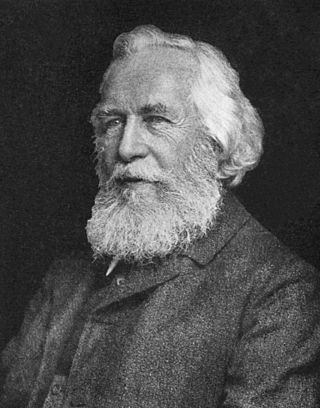
Ernst Heinrich Philipp August Haeckel was a German zoologist, naturalist, eugenicist, philosopher, physician, professor, marine biologist and artist. He discovered, described and named thousands of new species, mapped a genealogical tree relating all life forms and coined many terms in biology, including ecology, phylum, phylogeny, and Protista. Haeckel promoted and popularised Charles Darwin's work in Germany and developed the influential but no longer widely held recapitulation theory claiming that an individual organism's biological development, or ontogeny, parallels and summarises its species' evolutionary development, or phylogeny.

The Radiolaria, also called Radiozoa, are protozoa of diameter 0.1–0.2 mm that produce intricate mineral skeletons, typically with a central capsule dividing the cell into the inner and outer portions of endoplasm and ectoplasm. The elaborate mineral skeleton is usually made of silica. They are found as zooplankton throughout the global ocean. As zooplankton, radiolarians are primarily heterotrophic, but many have photosynthetic endosymbionts and are, therefore, considered mixotrophs. The skeletal remains of some types of radiolarians make up a large part of the cover of the ocean floor as siliceous ooze. Due to their rapid change as species and intricate skeletons, radiolarians represent an important diagnostic fossil found from the Cambrian onwards.
Proteus is an early Greek water god.
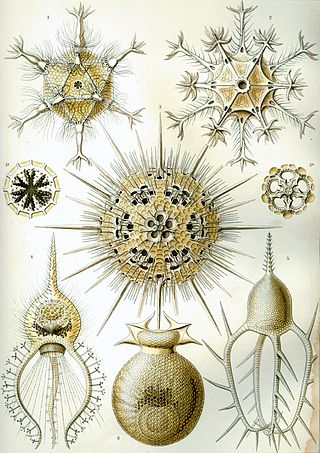
Phaeodarea or Phaeodaria is a group of amoeboid cercozoan organisms. They are traditionally considered radiolarians, but in molecular trees do not appear to be close relatives of the other groups, and are instead placed among the Cercozoa. They are distinguished by the structure of their central capsule and by the presence of a phaeodium, an aggregate of waste particles within the cell.

Kunstformen der Natur is a book of lithographic and halftone prints by German biologist Ernst Haeckel.
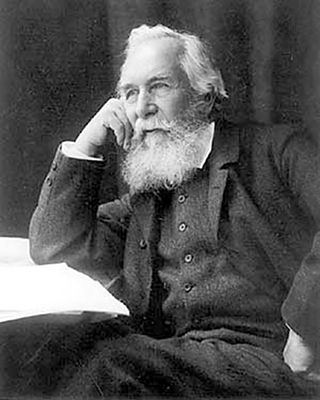
The term "world riddle" or "world-riddle" has been associated, for over 100 years, with Friedrich Nietzsche and with the biologist-philosopher Ernst Haeckel, who, as a professor of zoology at the University of Jena, wrote the book Die Welträthsel in 1895–1899, in modern spelling Die Welträtsel, with the English version published under the title The Riddle of the Universe, 1901.

William Pierce Brodkorb was an American ornithologist and paleontologist.
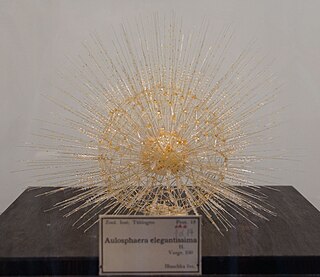
Aulosphaera is a genus of Cercozoa. The genus contains bioluminescent species. It one of two known bioluminescent phaeodarean genera, the other being Tuscaridium. The described bioluminescent species is Aulosphaera triodon Haeckel, 1887.
Siphonosphaera is a genus of radiolarians. The genus contains bioluminescent species. It is a genus of colonial radiolarians.

Spumellaria is an order of radiolarians in the class Polycystinea. They are ameboid protists appearing in abundance in the world's oceans, possessing a radially-symmetrical silica (opal) skeleton that has ensured their preservation in fossil records. They belong among the oldest Polycystine organisms, dating back to the lower Cambrian. Historically, many concentric radiolarians have been included in the Spumellaria order based on the absence of the initial spicular system, an early-develop structure that, by its lacking, sets them apart from Entactinaria despite their similar morphology. Living exemplars of the order feed by catching prey, such as copepod nauplii or tintinnids, on the adhesive ends of their pseudopodia extending radially from their skeleton; however, some have been observed as mixotrophs living in symbiosis with various photosynthetic algal organisms such as dinoflagellates, cyanobacteria, prasinophytes or haptophytes, which may cause their distribution to center in the greatest abundance and diversity within trophical waters.
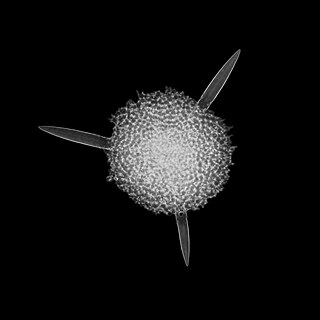
Spongodiscidae is a family of radiolarians in the order Spumellaria. According to the original description by Ernst Haeckel, members of the family have a flat discoidal shell, in which a simple spherical central chamber is surrounded by an irregular spongy framework.

Stylosphaeridae is a family of radiolarians in the order Spumellaria. According to the original description by Ernst Haeckel, members of the family have a spherical central capsule within a fenestrated spherical siliceous shell, with two radial spines opposite in one axis. They are solitary. i.e. not associated in colonies.
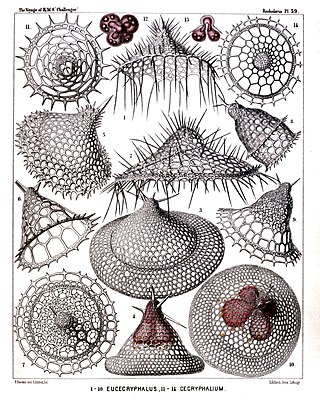
Clathrocyclas is a genus of radiolarians in the family Theoperidae.
Cornutanna is a genus of radiolarians in the order Nassellaria.

Collodaria is a unicellular order under the phylum Radiozoa and the infrakingdom Rhizaria. Like most of the Radiolaria taxonomy, Collodaria was first described by Ernst Haeckel, a German scholar who published three volumes of manuscript describing the extensive samples of Radiolaria collected by the voyage of HMS Challenger. Recent molecular phylogenetic studies concluded that there are Collodaria contains three families, Sphaerozodae, Collosphaeridae, and Collophidilidae.
The genus Stylodictya belongs to a group of organisms called the Radiolaria. Radiolarians are amoeboid protists found as zooplankton in oceans around the world and are typically identified by their ornate skeletons.
Rhaphidozoum is a radiolarian genus reported in the subfamily Sphaerozoidae. The genus contains bioluminescent species. It is a genus of colonial radiolarians.

Acrosphaera is a radiolarian genus in the Collosphaeridae. The genus contains bioluminescent species. It is a genus of colonial radiolarians.

Collosphaera is a radiolarian genus in the family Collosphaeridae. The genus contains bioluminescent species. It is a genus of colonial radiolarians.

Jane Furst is a contemporary English artist.














